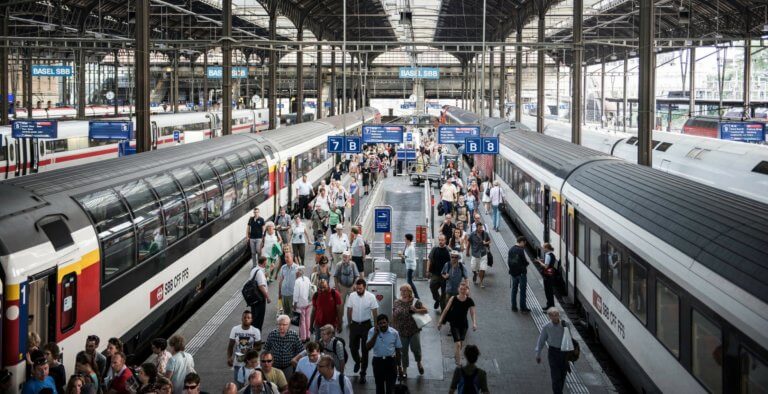by Conall Mac Aongusa, Transport Planner, member of RailHow, 08/07/2019
Railways can move goods very quickly and efficiently to their destination. In the face of the increasing challenges of climate change and the search for sustainable low emission transport solutions, rail is envisaged by many to have a big role to play. So why then are we not seeing global trends showing strong growth in the rail freight business?
In the European Union, the last two decades have seen consistent and concerted policy objectives to get a switch from road to rail to ease congestion on the road network and improve environmental conditions. But these policy initiatives have met with only limited success for many reasons including the complex challenge of introducing harmonised rail networks and standards across the EU 27 states and because road freight transport is more competitive in many European situations. While the total demand for land-based transport (in tonne-kilometres) in the EU grew by 11.1% between 2012 and 2017, the rail freight mode share decreased slightly by 0.5% from 18.5% to 17.3%.
| 2017 | Railway Network (Route km) | Freight Tonnage
(M-tonne) |
Rail Freight Tonnage
(M-tonne-km) |
Rail Freight Mode Share |
| European Union | 217 000 | 2 438 000 | 420 000 | 17.3 % |
| United States | 149 000 | 2 953 000 | 944 000 | 32 % |
| India | 67 000 | 2 436 000 | 620 000 | 25 % |
Source: based on Eurostat (EU) , OECD, Bureau of Transportation Statistics (US), Ministry of Railways (India)
Progress in achieving the shift to rail has been varied across EU states with most states showing a stable share of rail freight, but the most noticeable trend in the rail freight mode shares in the period 2012-2017 is the consistent reduction in the mode shares in the former Eastern Bloc countries as their motorisation levels increase and road freight takes an increasing market share. In the face of the challenges of climate change this is a big quandary not only for European rail operators but also for the EU as a whole.
On the other hand, in the USA where distances between sources and markets and between cities are much longer than in the densely populated EU, the trends in the modal shares of rail freight have been markedly different over time. The mode share of rail freight by ton-miles in the US in 2017 was 32% of all freight ton-miles down from 35% in 2012. There are considerable differences between the US and EU railway markets owing to structural operational and policy factors. Nonetheless the decline in rail freight modal share in a period of US economic expansion poses some questions and quandaries for the US authorities.
The railway network in India is the fourth largest in the world by kilometre length but it serves a population that is bigger than those of the EU and USA combined. The rail freight mode share in India however is also declining and at an increasingly rapid pace from 40% at the turn of the millennium in 2000 to less than 25% of tonne-km of freight in 2017. The reasons for this decline are many including in particular a lack of investment in the rail freight business and a complex rail freight tariff system managed by the highly centralised railway bureaucracy and the increasing competition from the road freight business as the road network investment increases and motorisation levels increase.
There are differences in the context and organisation of these three of the biggest global railway markets. Underlying and feeding into the high-level mode share statistics are the factors which determine why goods are transported by railway rather than another mode.
The reasons that companies choose to send their goods to market by rail or by road or by pipeline are many and complex and are very often context-specific for a particular product and market. Railways play an important role in a modern economy but they are only one part, or one option within the different transport modes that support a vast array of complex supply chain services.
Railways can be more efficient in particular cases for example where large volumes of goods are being shipped long distances between two points. The business case can be highly dependent on the type of goods or the commodity that is being shipped.
Railways are suitable for transporting high volumes of bulk commodities over longer distances such as coal or minerals or for industrial goods such as machinery. By contrast everyday consumer goods and foodstuffs in smaller or modest volumes are delivered in relatively short journeys and therefore it’s not economical to transport them by rail.
The decision to send goods by railway is a multi-faceted and complex decision that takes into account the type of goods or commodity, the volume of goods, the value of the goods, the timing and urgency of delivery, the available modal infrastructure for transport, the full cost of the journey from to A to Z and not simply from A to B, and the length of contractual commitment to using the railway as the mode of transport.
While there are any number of policy reasons for seeking to increase modal share of rail freight, including combating climate change, improving the environment and urban development and spatial policy, at the end of the day the commercial business case is the defining factor for deciding to choose which transport mode to choose for sending goods to market.
It would appear from the statistics at least that the overall global modal shares for rail freight are declining at a time when increasingly sustainable low emission transport solutions are required – a role that the railways are well positioned to play. This decline in rail freight is a quandary for railway authorities and governments around the world to resolve.


